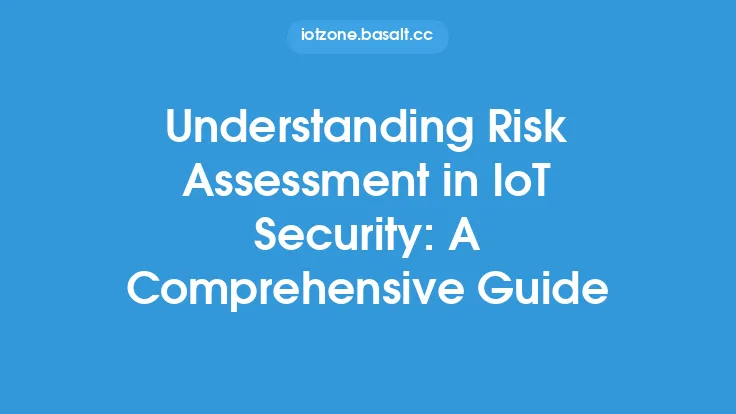The Internet of Things (IoT) has revolutionized the way we live and work, with an ever-increasing number of devices connected to the internet. However, this increased connectivity has also introduced new security risks, making network security a critical aspect of IoT. In this article, we will delve into the world of network security in IoT, exploring the fundamental concepts, technologies, and principles that underpin this complex and fascinating field.
Introduction to Network Security in IoT
Network security in IoT refers to the practices, technologies, and protocols used to protect IoT devices, networks, and data from unauthorized access, use, disclosure, disruption, modification, or destruction. This is a critical concern, as IoT devices often collect and transmit sensitive data, and a breach can have serious consequences, including financial loss, reputational damage, and even physical harm. IoT network security involves a range of activities, including threat detection, vulnerability assessment, penetration testing, and incident response.
Network Architecture in IoT
IoT networks typically consist of a large number of devices, including sensors, actuators, and gateways, which communicate with each other and with the cloud or other external systems. The network architecture in IoT is often characterized by a hierarchical or mesh topology, with devices communicating through wireless or wired links. Understanding the network architecture is essential for designing and implementing effective security measures, as it helps identify potential vulnerabilities and attack vectors. Key concepts in IoT network architecture include device management, network protocols (such as CoAP, MQTT, and HTTP), and data processing and analytics.
Security Threats in IoT Networks
IoT networks are vulnerable to a range of security threats, including device tampering, eavesdropping, man-in-the-middle attacks, and denial-of-service (DoS) attacks. These threats can be launched by malicious actors, such as hackers, or can result from accidental or intentional actions by authorized users. Common attack vectors in IoT networks include weak passwords, outdated software, and unsecured communication protocols. To mitigate these threats, it is essential to implement robust security measures, such as encryption, authentication, and access control.
Cryptography in IoT Network Security
Cryptography plays a critical role in IoT network security, as it enables secure communication between devices and protects data from unauthorized access. Common cryptographic techniques used in IoT include symmetric and asymmetric encryption, digital signatures, and hash functions. However, cryptography in IoT is often challenging due to the limited computational resources and power constraints of many IoT devices. As a result, lightweight cryptographic protocols and algorithms, such as Elliptic Curve Cryptography (ECC) and Advanced Encryption Standard (AES), are often used in IoT applications.
Network Protocols and Security
Network protocols, such as CoAP, MQTT, and HTTP, play a critical role in IoT communication, as they enable devices to exchange data and control messages. However, these protocols can also introduce security risks, such as vulnerabilities to replay attacks, eavesdropping, and tampering. To mitigate these risks, it is essential to implement secure protocol variants, such as DTLS (Datagram Transport Layer Security) and TLS (Transport Layer Security), which provide encryption, authentication, and integrity protection.
Secure Communication in IoT Networks
Secure communication is essential in IoT networks, as it enables devices to exchange data and control messages without compromising confidentiality, integrity, or authenticity. Key concepts in secure communication include encryption, authentication, and access control. In IoT, secure communication is often achieved through the use of secure protocols, such as IPsec (Internet Protocol Security) and TLS, which provide end-to-end encryption and authentication. Additionally, techniques such as secure key exchange and management are used to establish and manage cryptographic keys.
Device Security in IoT Networks
Device security is a critical aspect of IoT network security, as devices are often the weakest link in the security chain. Key concepts in device security include secure boot, firmware updates, and secure storage. Additionally, techniques such as device authentication and authorization are used to ensure that only authorized devices can access the network and exchange data. To further enhance device security, manufacturers often implement secure coding practices, such as secure coding guidelines and code reviews, to prevent vulnerabilities and bugs.
Network Security Monitoring and Incident Response
Network security monitoring and incident response are essential components of IoT network security, as they enable organizations to detect and respond to security incidents in a timely and effective manner. Key concepts in network security monitoring include log collection and analysis, anomaly detection, and threat intelligence. In the event of a security incident, incident response plans and procedures are used to contain, eradicate, and recover from the incident. This includes activities such as incident reporting, damage assessment, and post-incident activities.
Future Directions in IoT Network Security
The field of IoT network security is rapidly evolving, with new technologies, protocols, and standards emerging to address the unique security challenges of IoT. Future directions in IoT network security include the use of artificial intelligence and machine learning to detect and respond to security threats, the development of new lightweight cryptographic protocols and algorithms, and the implementation of secure software development practices, such as secure coding guidelines and code reviews. Additionally, the use of blockchain technology and other distributed ledger technologies is being explored to enhance security, transparency, and accountability in IoT networks.
Conclusion
In conclusion, network security in IoT is a complex and fascinating field that requires a deep understanding of the fundamental concepts, technologies, and principles that underpin it. By understanding the network architecture, security threats, cryptography, network protocols, secure communication, device security, and network security monitoring and incident response, organizations can design and implement effective security measures to protect their IoT devices, networks, and data from unauthorized access, use, disclosure, disruption, modification, or destruction. As the IoT continues to evolve and grow, it is essential to stay informed about the latest developments and advancements in IoT network security to ensure the confidentiality, integrity, and availability of IoT data and systems.





